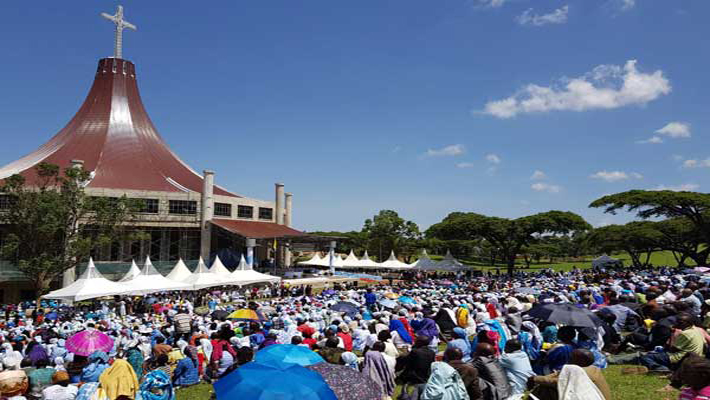 Pilgrims fetch "holy water" at the Subukia Shrine. The shrine, located in Nakuru County, has become famous and attracts people of faith and others from all over Kenya and beyond. It was named the Village of Mary Mother of God in 1984 by the late Michael Cardinal Maurice Otunga.
Pilgrims fetch "holy water" at the Subukia Shrine. The shrine, located in Nakuru County, has become famous and attracts people of faith and others from all over Kenya and beyond. It was named the Village of Mary Mother of God in 1984 by the late Michael Cardinal Maurice Otunga.
Its name has since changed to the Village of Mary Mother of God, or the National Marian Shrine.
It is still a famous shrine in Nakuru’s Subukia Sub-County that attracts many visitors daily.
"Subukia" is a Maasai word pronounced "isupuku," meaning "higher grounds."
The name aptly fits the location of this famous shrine, which is 210 kilometres west of Nairobi and 40 kilometres from Nakuru.
The shrine, which has attracted both Christians and non-Christians since it was started in 1985,
Visitors to the shrine have to be prepared for a 10km-walk from the Subukia-Nyahururu road, before climbing a meandering footpath leading to a spring.
At the foot of the hill is a big white cross that can be seen easily as one approaches Subukia Valley.
Buried at the foot of the cross is a piece of rock from the Grotto at Lourdes in France, a stone from River Jordan in Israel and another from the Marian Shrine at Medjugorje in Bosnia-Herzegovina.
The footpath leading to the spring is steep and one has to take 12 steps of cross. The steps symbolise the suffering Jesus underwent before crucifixion.
The spring water is regarded holy and faithful wash their hands and feet with it for healing. Some carry the water for future use.
ATTRACTIONS
Flowing springs
The water from the spring flows for only a few metres from the statue before disappearing underground, probably to reappear several kilometres down the valley to irrigate lush plantations.
The prayerful environment and the serene nature of the place helped me find a deep relationship with my God. On completion the Church (capacity 4500 seats) will resemble the image of the Crown of Mary. It is a beautiful House of God.




 We support individuals by; providing placements, assisting with information and travel or other insurance products, hosting pre-departure preparation, supporting individuals and families whilst overseas with us and on their return.
We support individuals by; providing placements, assisting with information and travel or other insurance products, hosting pre-departure preparation, supporting individuals and families whilst overseas with us and on their return. UniversalGiving™ is an award-winning website that helps people give and volunteer with the top-performing projects all over the world. All projects are vetted through UniversalGiving's trademarked, proprietary Quality Model.™ 100% of each donation goes directly to the cause.
UniversalGiving™ is an award-winning website that helps people give and volunteer with the top-performing projects all over the world. All projects are vetted through UniversalGiving's trademarked, proprietary Quality Model.™ 100% of each donation goes directly to the cause.